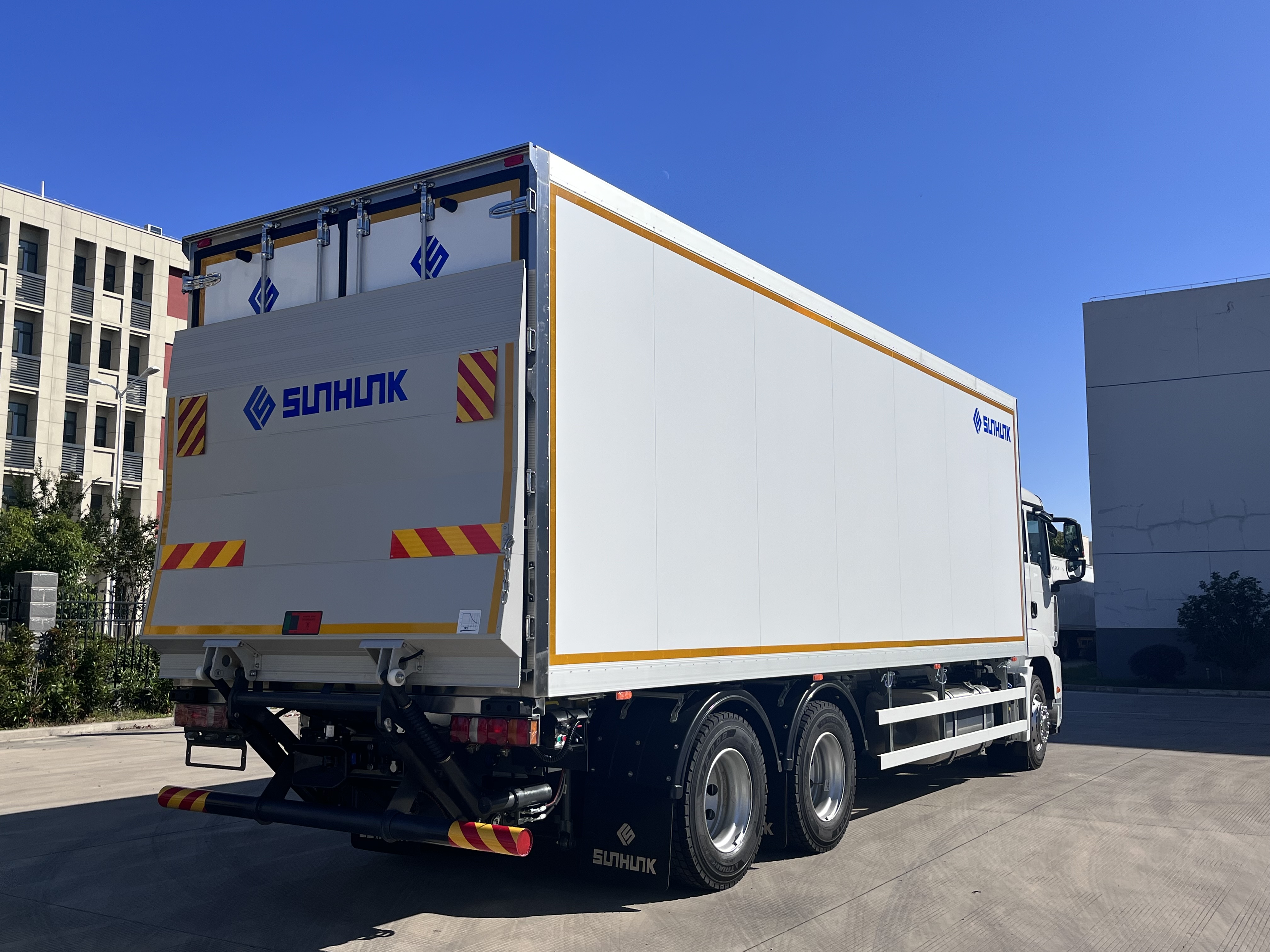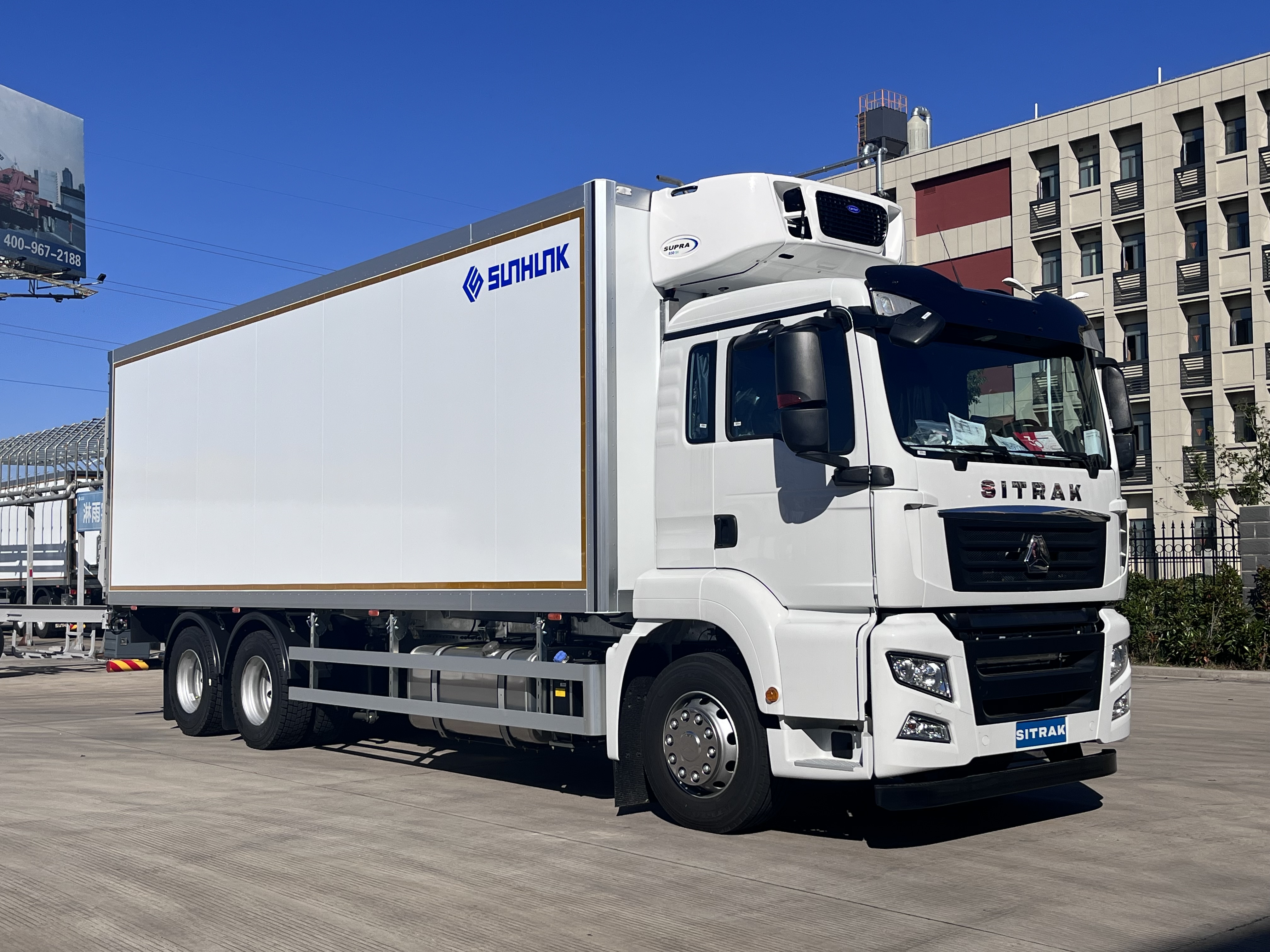- PRODUCTS
- SOLUTION
- SERVICE
- NEWS
- ABOUT US
Enclosed refrigerated trailers offer superior temperature control, with fluctuations within ±1.5℃, making them suitable for long-distance transportation of high-value goods, with loss rates below 2%. In contrast, open refrigerated trucks experience temperature fluctuations of up to ±5℃, with loss rates reaching 10%, making them more suitable for short-distance multi-point deliveries.
Due to their sealed structure, enclosed refrigerated trailers can more stably control the temperature and humidity inside the compartment, preventing external environmental factors from affecting the cargo. When the external temperature fluctuates by more than 10°C, the internal temperature of an enclosed trailer typically fluctuates by no more than 1.5°C, while the internal temperature of an open refrigerated truck can fluctuate by more than 5°C.
Perishable goods are very sensitive to this difference in temperature control. For each 1°C increase in temperature fluctuation during transport, goods loss rates rise by 3% to 5%.

Data on the transport of 2023 vehicle transportation of a certain logistics company reveals that using enclosed refrigerated trailers for long-distance leaving, the proportion of deteriorating goods was reduced to less than 2.5%, but if an open-type refrigerated truck is used instead in relatively sealed surroundings where only bargains will be accepted at any time, a high rate of cargo loss up to 12%. Enclosed refrigerated trailers are almost consistent in energy consumption, with an EER of normally 3.5–4.0 for the compressor but open refrigerated trucks usually have an EER below 3. Transport route for a total of 1500 km, assuming enclosed refrigerated trailers saves about 600 RMB in energy costs.
Transportation Type | Enclosed Refrigerated Trailer | Open Refrigerated Truck | Data Comparison |
Short-Distance Delivery | Longer loading and unloading time, suitable for large-volume transport | Fast loading and unloading, suitable for frequent operations | Enclosed truck loading and unloading time: 10-15 minutes, open truck: 3-5 minutes |
Multi-Point Delivery | Lower efficiency, suitable for single destination | More flexible, higher efficiency for multi-point delivery | Enclosed truck driving time: 5.5 hours, open truck: 6 hours |
Urban Operation | Inconvenient to operate, requires more turning space | Suitable for narrow spaces, flexible operation | Open truck can be used in areas with a height limit below 2.5 meters, enclosed truck requires more space |
Long-Distance Transport | More fuel-efficient, high efficiency for long-distance transport | Relatively high fuel consumption, low long-distance efficiency | Enclosed truck fuel consumption per 100 km is 8% lower, saves 600 RMB in long-distance fuel costs |
Single Destination Transport | Suitable for large-volume cargo transport | Not suitable for large-volume transport | Enclosed truck can load 20-30% more cargo, reducing the number of trips |
Compared with other types of refrigerated trailers, enclosed refrigerated trailers are designed to keep the rest of your products safe during transportation due to their totally covered structure style. Closed trailers refrigerated transport, rainproof, windproof dustproof manner of sealed thermal-insulating devices to external factors, especially the worst that such as in heavy precipitation for a long time and under strong winds and high temperatures affect inside temperature-shipping quality play an important role. During a 2024 rainstorm, the rate of cargo damage for enclosed refrigerated trailers was less than 1%, while for open refrigerated trucks, it exceeded 8 times that percentage.
Closed refrigerated trailers are naturally more difficult to theft, anti-damage. Because the cargo is hidden in a compartment that cannot be opened while on the move, there is very little opportunity for theft or to inflict damage on people during road transport. It is especially relevant for the movement of high-value commodities like consumer electronics or life sciences products. Incidents of cargo theft due to vehicle structure occurred six times more frequently for vehicles open refrigerated trucks than for enclosed trailers over the last three years, risking both shipment security and brand image.
Refrigerated semi-open trucks are a bit convenient for loading and unloading but have great risks for cargo security. Among these conditions, transport is the condition that affects most because when transported from one place to another, goods are always exposed to external environmental factors. In long-distance transportation, the damage rate of open refrigerated trucks is about 15% higher than that of enclosed trailers, most have temperature-sensitive frozen foods and pharmaceuticals where the probability to be damaged is more.
Safety performance also reflects in vehicle stability and impact resistance. Enclosed refrigerated trailers generally have a more robust compartment structure with better impact resistance. When driving on rugged or complex road conditions, the enclosed compartment effectively reduces cargo shaking and displacement caused by road bumps, thereby reducing the risk of cargo damage. A cold chain logistics company once conducted a comparative experiment in a simulation test: driving 30 kilometers on bumpy roads, the cargo damage rate of enclosed refrigerated trailers was less than 2%, while that of open refrigerated trucks exceeded 12%.
Although enclosed refrigerated trailers have apparent advantages in terms of safety, their initial purchase cost and maintenance expenses are relatively high. According to market data, the average purchase cost of enclosed refrigerated trailers is about 450,000 RMB, while the average cost of open refrigerated trucks is around 300,000 RMB. In addition, the daily maintenance costs of enclosed trailers, such as the inspection and repair of the sealing system, are higher overall.
From a design perspective, enclosed refrigerated trailers use a fully enclosed structure with better insulation and thermal performance. The compartment usually consists of multiple layers of insulating materials and is equipped with an advanced temperature control system that can maintain temperature fluctuations within ±1.5°C. In contrast, open refrigerated trucks, due to their semi-open design, allow external air to enter easily, with temperature fluctuations around ±5°C, posing a significant risk when transporting temperature-sensitive goods.
Enclosed refrigerated trailers are more suitable for long-distance, large-volume transport and goods requiring high temperature control, such as seafood, meat, and pharmaceuticals. For these types of cargo, even minor temperature fluctuations can cause spoilage. According to industry data, when using enclosed refrigerated trailers for long-distance transportation of perishable foods, the loss rate is generally below 2%, while using open refrigerated trucks can result in a loss rate of up to 10%. Enclosed refrigerated trailers' purchase and maintenance costs are relatively high. The average purchase cost is about 400,000 to 500,000 RMB, while the cost for open refrigerated trucks ranges from 250,000 to 350,000 RMB. Although enclosed trailers have advantages in fuel consumption and cargo loss rate, their high initial investment leads some small businesses to opt for open trucks.

Because the compartment is completely closed, cargo is not easily stolen or damaged during transportation, while open refrigerated trucks have a higher security risk due to the partial exposure of goods. A transportation safety survey showed that the risk of cargo theft in open refrigerated trucks during long-distance transportation is nearly four times higher than in enclosed trailers, which is a critical concern for companies transporting high-value goods.